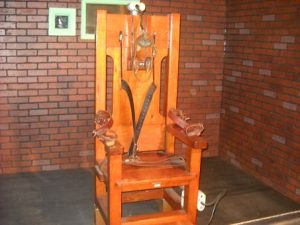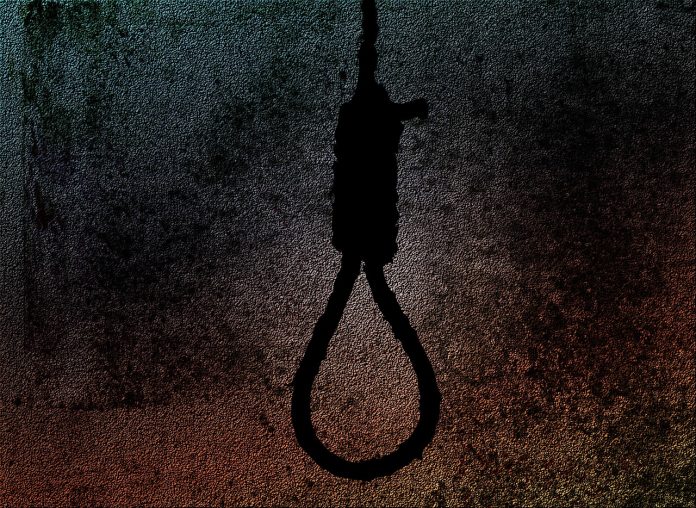This article is written by Sarthak Gupta, a student of the Institute of Law, Nirma University. This article discusses provision related to the execution of capital punishment in India and an alternative form of execution that may be used in place of hanging.
Table of Contents
Introduction
Execution of capital punishment in India is basically done through two methods.
- Hanging by the neck until dead
It is provided under Section 354(5) of CrPC, 1973 and Army Act, Air Force Act and Navy Act.
- Being shot to death
It is provided under the provision of the Army Act, the Air Force Act and Navy Act for some specific offences.
Execution of capital punishment under the Code of Criminal Procedure, 1973, and the prison manual
Death sentence in India, under the Code of Criminal Procedure, 1973 is done through hanging the person till death. Along with Section 354(5) of the CrPC, 1973 execution of the death sentence is done through the provision of jail manuals of the respective states. Some of the general provision mentioned in the Jail manual of most of the states are as follows.
Diet schedule
An ordinary diet of a labouring convict is given to the condemned prisoners. Before giving any food to condemned prisoners, food should be tested by the deputy superintendent, assistant superintendent or medical subordinate and food should be delivered to the convict in the presence of deputy superintendent, assistant superintendent or medical subordinate.
Time of execution
Generally, execution of Condemned prisoner takes place early in the morning before it is bright. time varies from season to season in different states. Jail Manual of Punjab and Haryana, for instance, provides following time.
|
November to February |
8 AM |
|
March to October |
7 AM |
|
May to August |
6 AM |
Solitary confinement
Condemned prisoners should be put in solitary confinement under a charge of a guard, day and night. He should be allowed to meet or communicate with only those people who are authorized by the superintendent.
Regulation regarding rope to be used
- A manilla rope which is of one diameter shall be used for the execution. It should be 19 feet in length, sufficient tensile and has strength to bear a weight of 280 lbs with 7-foot drop and capable of easily passing through noose ring.
- At least two such kinds of rope should be available at the jail where such execution is going to take place.
- The ropes shall be tested in the presence of superintendent, at least a week before the date fixed for the execution
- After testing it should be locked in a place of safety.
- An evening before the execution it should be checked to see that it has not received any injury after the test.
- Condemned prisoner on his admission in prison should be checked carefully and any item that may be considered as dangerous or inexpedient shall be taken from him. Before putting him in the cell, the cell should be carefully examined to ensure that there is nothing dangerous which may be used by the person as a weapon or instrument to commit suicide.
- When the door of the cell in which the prisoner is kept, is opened his hand should be handcuffed and if that person declines to handcuff his hand at least three members of the establishment shall be present there. The locks of the cell in which he is kept shall not be opened by any keys other than the specific key of his cell.
- The body of such condemned prisoner should remain suspended half an hour and shall not be taken down until the medical officer declares him life extinct.
Executions in accordance with the Army Act, Air Force Act, and Navy Act
The Air Force Act, Army Act and Navy Act provide for the execution of the death sentence in two ways. The first way is hanging by the neck until death and the second way of being shot to death. For instance, section 34 of the Air Force Act, 1950 empowers the court-martial to impose the death sentence for the offences which are mentioned in section 34(a) to (o)
Section 163 of the Air force Act provides that according to the discretion of court-martial accused can sentence for capital punishment either by hanging or by being shot to death. The provisions of the Army Act, 1950(Chapter VII ), The Navy Act 1957(Section 147) are similar in nature to that of `The Air Force Act, 1950 providing for the option of the execution of the capital punishment by being shot to death and hanging by the neck till death
Execution of capital punishment by Hanging: A need for change
The right to die by a dignified procedure of death is a fundamental right of a person. In Deena v. Union of India (1983)4 SCC 645, the Supreme Court stated that execution of capital punishment should satisfy the following criteria.
- It should be as simple and as quick as may be possible
- It should bring immediate unconsciousness of the person passing quickly into the death
- It should not involve any kind of mutilation.
Further, a resolution passed by the United Nations Economic and Social Council states that when capital punishment is executed, it should be carried out with the minimum possible suffering
In execution of death sentence by hanging the condemned prisoner till death, a prisoner is made to stand on a trapdoor, and when the trap is released he falls several feet until stopped by the rope tied around his neck , this result in breaking of the neck of the person but many time when neck does not break the prisoner strangles to death.
In the case, if the drop is too short, the prisoner dies of strangulation( slow and agonizing death) and if the drop is too long, the prisoner dies of decapitation (complete separation of the head from the body).
In the words of Warden Duffy of San Quentin, a high-security prison in the USA,
“The horrifying experience for the condemned prisoners actually starts a day before the actual hanging take place. He is weighed, measured for length of the drop to assure breaking of the neck, etc. Many times when the neck does not break prisoner strangles to death and his eyes pop out, his tongue swells and stick out from the mouth and he discharges urine and faeces”
Justice Bhagwati in his dissenting judgment in the case Bachan Singh v. the State of Punjab (1982) 3 SCC 25 described hanging by rope as barbaric and inhuman as entailing physical pain and agony. Further while hearing a PIL filed by a lawyer regarding the right of a condemned prisoner to have a dignified mode of execution former Chief Justice Dipak Misra said legislature shall look at changing the law so that a convict, facing the capital punishment, dies “in peace, not pain”.
While giving a dissenting judgment Justice Egonda Ntende of the Supreme Court of Uganda pointed out in Attorney General v. Susan Kigula & 416 others [2006] various reason why hanging should be considered cruel and inhuman treatment.
- The wrists and ankles of the prisoner are tied to restrain him.
- The prisoner cannot react to pain and feeling of asphyxia, by the usual physiological responses of crying out or moving violently.
- The person hanged often sweats, drools, the eyes bulge and defecates.
What are the other options available for executing capital punishment
If not the Hanging then what? Over the years many kinds of methods have developed to give capital punishment, some of those popular methods still practised are as follows.
Beheading
This method usually involves chopping off the person’s head with an axe or sword. This method was quite popular in England and Germany in the 16th and 17th centuries. In 1747 the last beheading was done in the United Kingdom. Nowadays this method is not generally used by countries around the world except a few countries like Iran, Saudi Arabia, and Yemen, Qatar. The judiciary in various judicial pronouncements and the UN has also ruled it to be one of the farcical and an arbitrary method of capital punishment.
Gas chamber
In this method of execution, a prisoner is put in an airtight chamber and then after a signal, the executioner opens a valve which allows hydrochloric acid to flow into a pan. After another signal sodium cyanide crystals are dropped which produces hydrocyanic gas. Hydrocyanic destroys the body’s ability to process haemoglobin.
Nevada was the first state to legally allow the use of gas chambers to execute the prisoners and at the present seven states in the USA i.e, Arizona, California, Wyoming, Oklahoma, Missouri, Alabama allows the use of this method.
Human Rights Committee held in Ng v. Canada, Communication No. 469/1991 that execution by gas asphyxiation amount to cruel and inhuman treatment. A national court in the USA held in Fierro v. Gomez, 865 F.Supp. 1387 (N.D. Cal. 1994), that execution by gas asphyxiation is a cruel and unusual form of punishment. This method is also expensive and cumbersome.

Electric Chair
In this method, a person is strapped to a specially built chair and a jolt is given to him. The intensity of jolt varies according to the weight of the person. Two countries that have ever used this method are the United States and the Philippines. However, the Philippines replaced this with the death squad in 1976. In U.S.A currently, 9 states allow this method.
The Nebraska Supreme Court in State v. Mata, 275 Neb. 1 N.W.2d 229 (2008) described the electrocution method to give capital punishment as cruel and unusual.
Stoning
Stoning basically involves throwing stones on the person until his death. Countries like Indonesia, Iran, Nigeria, Pakistan, Saudi Arabia, UAE, and Yemen allows the use of it.
The United Nations Human Rights Commission pointed out that execution by stoning was a “particularly cruel or inhuman means of execution” (Resolution 2005/29: The Question of the capital punishment, para. 7(i)).

Lethal injection
In this method, condemned prisoners are injected 3 different types of drugs in lethal quantity. First Sodium Thiopental is injected, to let him fall into a deep sleep. Then after it Pancuronium Bromide, a muscle relaxer, is injected, it causes the inmate to stop breathing because of paralysis of the diaphragm and lungs. Finally, Potassium Chloride is injected which stops the heart. This method, of all those available, appears to be the quickest and least painful.
This method is the most common form of execution in the U.S.A where most of the execution is done through this method only. Out of 749 executions in the USA up to the year 2000, 586 out of lethal injection. In Baze v. Rees 553 U.S. 35 (2008) the Supreme Court of USA held that execution of capital punishment through lethal injections does not amount to cruel and unusual punishment under the Eighth Amendment.
Law Commission of India conducted a survey in the year 2003 among judges where 80% of the judges suggested that administering the lethal injection should be the other mode of execution of death sentence in India.
Law Commission of India pointed out in its 187th report that there is a significant increase in the number of countries which have adopted the method of execution by lethal injection.
Comparison of death by hanging with death by lethal injection
|
HANGING |
LETHAL INJECTION |
|
Uncertainty as to the time required for the prisoner to become unconscious |
Unconsciousness takes place immediately and the person dies in sleep |
|
Chances of causing lingering death |
Not causes a lingering death. |
|
Most of the countries have either abandoned it or are in the process of abandoning it, considering it not to be a civilized mode of execution. |
It is getting acceptance of most of the countries around the world as a civilized mode of execution. |
|
Mutilation involved |
Involvement of no mutilation |
|
Not generally swift |
It is the painless and swift method of execution. |
|
Execution process takes more than 40 minutes to declare prisoner to be dead |
In just 5 to 9 minutes prisoner is declared to be dead |
Conclusion
The author would like to conclude by saying that injection is the most acceptable and humane method of sentences and there is a need to bring a change in the present law regarding the execution of the capital punishment in India. The lethal injection should be provided as an alternative mode of execution of death sentence along with the existing mode of execution of as provided in section 354(5) of the Cr.PC, 1973, Army Act, Navy Act, and Airforce Act.
 Serato DJ Crack 2025Serato DJ PRO Crack
Serato DJ Crack 2025Serato DJ PRO Crack











 Allow notifications
Allow notifications



